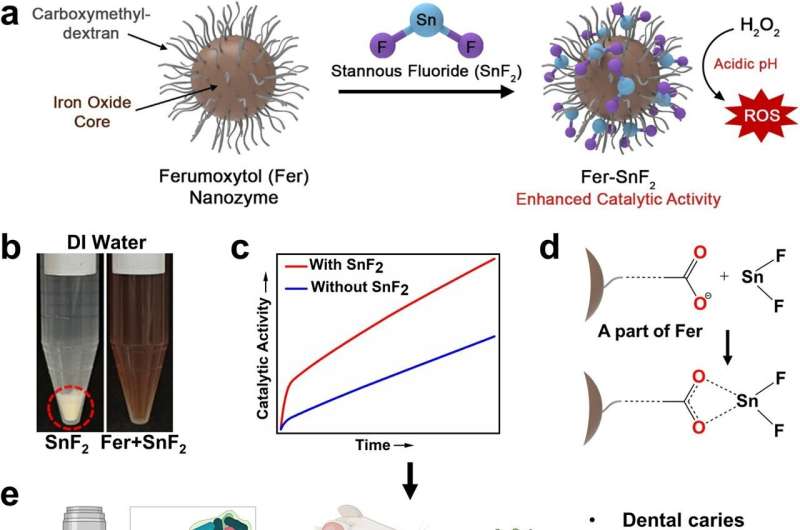This article has been reviewed according to Science X's editorial process and policies. Editors have highlighted the following attributes while ensuring the content's credibility:
fact-checked
peer-reviewed publication
trusted source
proofread
Combined treatment takes a bite out of tooth decay

The sting of a toothache or the discovery of a cavity is a universal dread. Dental caries, more commonly known as tooth decay, is an insidious adversary, taking a toll on millions of mouths worldwide. Caries can lead to pain, tooth loss, infection, and, in severe cases, even death.
While fluoride-based treatments have long been the gold standard in dentistry, this singular approach is now dated and has limited effect. Current treatments do not sufficiently control biofilm—the main culprit behind dental caries—and prevent enamel demineralization at the same time. This dual dilemma becomes particularly pronounced in high-risk populations where the onset of the disease can be both rapid and severe.
Now, a study from a team of researchers led by Hyun (Michel) Koo of the University of Pennsylvania's School of Dental Medicine in collaboration with David Cormode of Penn's Perelman School of Medicine and School of Engineering and Applied Science has unveiled an unexpected synergy in the battle against dental caries.
Their research revealed that the combination of ferumoxytol (Fer) and stannous fluoride (SnF2) could point at a potent solution against dental caries. Their findings were published in Nature Communications.
"Traditional treatments often come short in managing the complex biofilm environment in the mouth," Koo, senior co-author on the study, says. "Our combined treatment not only amplifies the effectiveness of each agent but does so with a lower dosage, hinting at a potentially revolutionary method for caries prevention in high-risk individuals."
Their findings include the ability of Fer to stabilize SnF2, the heightened catalytic activity of Fer when combined with SnF2, and the formation of a protective Fe/Sn/F-rich film on tooth enamel, which can serve as a shield against further demineralization. What's more, this combined therapy doesn't disrupt the ecological balance of the oral microbiota and has no adverse side effects on the surrounding host tissues.
Cormode, senior co-author of the paper, says, "What excites us most about these findings is the multi-faceted approach to caries prevention. It's not just about inhibiting bacterial growth or protecting the enamel; it's a holistic method that targets both the biological and physicochemical aspects of dental caries."
The researchers also note that, beyond this protective and proactive measure, an intriguing secondary benefit surfaced. Many children with severe tooth decay also suffer from iron deficiency anemia. Using Fer might address the dental and anemia concerns simultaneously.
Reflecting on the next steps, Koo says, "While we are happy with these initial findings, we still aim to dig deeper in understanding the intricate ways Fer and SnF2 synergize to boost the therapeutic effects."
Another significant advantage of this combined treatment is the promise of a quick transition to clinical applications. Since Fer is an off-the-shelf iron oxide nanoparticle formulation, using it topically at a fraction of its approved systemic dosage could fast-track its path to practical applications and commercialization without the long, arduous journey of new drug approvals.
Looking ahead, further research is required into the exact mechanisms of interaction between SnF2 and Fer, the reactive oxygen species generation process, and the formation and efficacy of the protective enamel film.
"There's potential here not just in dental care but in exploring how this combination can be targeted against other biofilms," Cormode says.
More information: Yue Huang et al, Iron oxide nanozymes stabilize stannous fluoride for targeted biofilm killing and synergistic oral disease prevention, Nature Communications (2023). DOI: 10.1038/s41467-023-41687-8




















